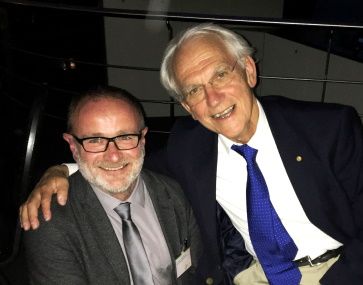»We're about even!« – Fraunhofer IOF alumnus Dr. Alexandre Gatto

If in the next couple of years car windows or windows in trams display personalized information, respond to our gestures, or provide temperature readings, this could be one of the projects currently being worked on by Alexandre Gatto, Director of Microstructured Optics at Carl Zeiss in Jena, and his team. Gatto predicts the coming years will see the arrival of the first applications for smart glass, a technology that his team has devoted its energies to advancing over the last few years. The fact that Nobel Prize judges have so far overlooked Gatto's team for their awards is no reflection on the quality of their work, more of which later. From Marseille, Gatto moved to the Fraunhofer Institute for Optics and Precision Engineering IOF to take up a postdoctoral position, and, with a few brief in between stints elsewhere, the physicist has stayed loyal to the Jena location, the field of optics and also the IOF.
You have been working at Fraunhofer for more than five years. How did you end up at the IOF?
It was simple! After obtaining my PhD from the Institut Fresnel at Aix-Marseille University, I was looking for a position. Back then, there was an exchange program called Training and Mobility Research, which the Fraunhofer IOF also ran. The IOF already had a big reputation in my specialist field in those days, and there was an 18-month position available that matched my interests in a number of areas. I defended my doctoral thesis in Marseille, and then got straight on the plane to take a look at the IOF in Jena. Back then, the Institute wasn't as large as it is today, but, after extending my contract, I ended up staying there for 6 years.
What were your specialist areas?
One of the research aims for this EU-funded Training Mobility Research project was optical mirror systems for free-electron lasers, which have to be extremely robust. I did my doctorate on optical layers and joined the IOF's Coatings department headed by Prof. Norbert Kaiser. In the department we worked on special coatings for the UV/VUV segment. This involves using a synchrotron light source, which requires very large facilities, such as those located in Trieste or Berlin. The light from this source is enhanced in a mirror system. Due to the intense synchrotron light, extremely resistant coatings are required. We achieved good results in designing layer systems. But in addition to optical properties, the material matters. Following this project, I managed various industrial projects, also with different departments of the IOF, lastly as group manager for VUV Optical Coatings. For example, in the UV/VUV spectral range, I developed various processes as well as design coatings for the optical industry.
What is special about Fraunhofer?
It's Fraunhofer´s positioning, right at the half-way point between basic research and research for industry. And of course the working atmosphere is very good and extremely productive. For me, the Fraunhofer model is still the best link bridging research and application. The Fraunhofer model also offers many advantages to scientists who are graduating and want to go to the industry. For me personally, my time at Fraunhofer was the best possible preparation for then going on to the Zeiss Group in 2005.
Which skills from Fraunhofer do you still use today at the Zeiss Group?
I prepared for my current job by studying for a Master of Business Administration. A number of employees were given the chance to do this MBA program alongside their job. The program at Bradford University School of Management was very extensive, and things I learned still help me today in my role as a manager. At the same time, I actually also acquired quite a few projects for Fraunhofer – so we're probably about even. Siriously - I am very thankful for this opportunity, and I still regularly work with Fraunhofer on projects.
What made you opt to come to Germany?
In Germany, there's also the Max Planck Society, but there are hardly any comparable examples from other countries that you could name. Although there are research institutions with a similar focus for example in France or other European countries, they are nowhere near as successful – there is still nothing to really match it. On the other hand, we should ceep in mind, that also the Fraunhofer-Gesellschaft wasn't set up overnight.